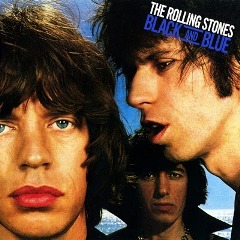Rolling Stones – Black And Blue 1976
Rolling Stones – Black And Blue (1976)

01. Hot Stuff – 5:20
02. Hand Of Fate – 4:28
03. Cherry Oh Baby (Eric Donaldson) – 3:52
04. Memory Motel – 7:06
05. Hey Negrita (Inspiration by Ronnie Wood) – 4:57
06. Melody (Inspiration by Billy Preston) – 5:48
07. Fool To Cry – 5:04
08. Crazy Mama – 4:34
Personnel:
- Mick Jagger – lead & backing vocals, percussion, rhythm guitar (08), electric & acoustic piano (04,07)
- Keith Richards – guitar, backing and lead vocals, Fender Rhodes electric piano (04), bass (08)
- Charlie Watts – drums and percussion
- Bill Wyman – bass guitar and percussion
+
- Ronnie Wood – guitar (03,08), lead guitar (05), backing vocals (01,02,04,05,08)
- Billy Preston – harmony vocals (06), piano (01,02,05,06,08), organ (05,06), string synthesizer (04)
- Nicky Hopkins – piano, organ (03), ARP String Ensemble (07)
- Harvey Mandel – electric guitar (01,04)
- Wayne Perkins – acoustic & electric guitar (02,04,07)
- Ian Stewart, Ollie Brown – percussion
- Arif Mardin – horn arrangement (06)
The Rolling Stones recorded Black and Blue while auditioning Mick Taylor's replacement, so it's unfair to criticize it, really, for being longer on grooves and jams than songs, especially since that's what's good about it. Yes, the two songs that are undeniable highlights are "Memory Motel" and "Fool to Cry," the album's two ballads and, therefore, the two that had to be written and arranged, not knocked out in the studio; they're also the ones that don't quite make as much sense, though they still work in the context of the record. No, this is all about groove and sound, as the Stones work Ron Wood into their fabric. And the remarkable thing is, apart from "Hand of Fate" and "Crazy Mama," there's little straight-ahead rock & roll here. They play with reggae extensively, funk and disco less so, making both sound like integral parts of the Stones' lifeblood. Apart from the ballads, there might not be many memorable tunes, but there are times that you listen to the Stones just to hear them play, and this is one of them. ---Stephen Thomas Erlewine, AllMusic Review
Nowym gitarzystą The Rolling Stones został Ronnie Wood (wcześniej członek The Jeff Beck Group i The Faces, a także solowego zespołu wokalisty obu tych grup, Roda Stewarta). Chociaż Keith Richards i Mick Jagger już wcześniej mieli okazje z nim współpracować (gdy nagrywał swój solowy debiut, "I've Got My Own Album to Do" z 1974 roku), nie od razu zdecydowali się na zatrudnienie własnie jego. Wcześniej przesłuchali wielu innych gitarzystów, wśród których znaleźli się Harvey Mandel (ex-Canned Heat) i Wayne Perkins (muzyk sesyjny) - partie obu wykorzystano nawet na albumie - a także Steve Marriott (ex-Small Faces, Humble Pie), Peter Frampton (ex-Humble Pie), oraz Jeff Beck i Rory Gallagher. Dwaj ostatni nie mieli nawet pojęcia, że biorą udział w przesłuchaniu (choć drugi z nich spędził z zespołem kilka dni na wspólnym graniu), później zaś zgodnie twierdzili, że nie dołączyliby do zespołu. Obaj byli przecież liderami własnych grup i nie chcieli z tego rezygnować, by podporządkowywać się spółce Jagger/Richards. Wood najwyraźniej nie miał z tym problemu. Zresztą jego udział na "Black and Blue" ograniczył się do zagrania w ledwie trzech utworach.
Opisane wyżej wydarzenia są z pewnością ciekawsze niż sam album. Bo "Black and Blue" był, w chwili wydania, najsłabszą pozycją w dyskografii The Rolling Stones. Gdzieś uleciała cała energia, od której kipiał poprzedni longplay, "It's Only Rock 'n' Roll". Słychać to szczególnie w tych bardziej dynamicznych utworach, którym przydałoby się więcej czadu, ale zespół gra w nich niemrawo, jakby bez przekonania ("Hand of Fate", "Hey Negrita", "Crazy Mama"). Jednak problemem jest nie tylko wykonanie - same kompozycje są kompletnie pozbawione wyrazu. Ballady wypadają nużąco ("Memory Hotel", "Fool to Cry"), nieciekawie wyszedł kolejny flirt z funkiem (monotonny i zdecydowanie za długi "Hot Stuff"), podobnie jak sięgnięcie po wpływy jazzowe ("Melody"). Największą porażką jest jednak zupełnie nowy dla zespołu eksperyment ze stylistyką reggae - "Cherry Oh Baby" (z repertuaru Erica Donaldsona). Nie przepadam za tym gatunkiem muzyki, a ten kawałek ma wszystkie jego wady, czyli identyczny, jak we wszystkich innych utworach reggae, rytm, a także irytujące wokalizy.
Bardzo brakuje na tym albumie Micka Taylora, którego partie tak ekscytowały na poprzednich longplayach grupy. Skład z Ronniem Woodem także miewał swoje wzloty, ale na "Black and Blue" próżno ich szukać. ---Paweł Pałasz, pablosreviews.blogspot.com
download (mp3 @320 kbs):
Last Updated (Tuesday, 11 December 2018 17:10)








